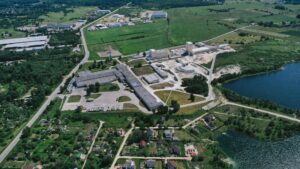
Best Practices for Landscape Planning and Designing for Industrial Facilities

When it comes to industrial facilities, landscape planning and designing play a crucial role in creating a harmonious and sustainable environment. For example, industrial facilities can be designed to have green walls, roof gardens, windbreaks, and other features that are aesthetically pleasing, reduce energy consumption, and improve air quality.
Incorporating well-designed landscapes around industrial facilities not only enhances the aesthetics of the area but also contributes to the overall well-being of the environment, workers, and surrounding communities.
In this article, we’ll explore the best practices for incorporating green spaces, native species, and thoughtful design elements to enhance the overall aesthetic and functionality of industrial landscapes.
1. Create a Greenbelt to Balance Industry and Nature
One of the key aspects of effective landscape planning is the creation of a greenbelt around the industrial facility.
Greenbelts serve as a buffer zone, providing a visual break between the factory and its surroundings. They also offer an opportunity to integrate native plants, trees, and shrubs, promoting biodiversity and attracting local wildlife.
2. Use More Native Tree Species
Choosing local and native tree species is not only a sustainable choice but also enhances the landscape’s resilience.
Native trees are adapted to the local climate and require less maintenance, making them an ideal choice for industrial landscapes. Their growth and development contribute to a healthier ecosystem while providing shade and visual appeal.
3. Minimizing Water-Intensive Vegetation
Water scarcity is a growing concern, and minimizing the use of water-intensive grass and plants in industrial landscape design is crucial. Opt for drought-resistant vegetation that requires less water while maintaining the aesthetic value. This not only conserves water but also reduces the overall maintenance costs.
4. Creating a Serene Environment for Workers
Industrial facilities can be bustling with activity, and creating a soothing environment for factory workers is essential. Incorporate elements like shaded seating areas, walking paths, and small garden spaces where employees can take a break and rejuvenate. A well-designed landscape contributes to a positive work atmosphere, boosting employee morale and productivity.
5. Paving with Perforations
Innovative landscape design involves using permeable pavements with perforations that allow rainwater to penetrate the ground. This promotes groundwater recharge, reducing runoff and the risk of flooding. Permeable pavements also help filter pollutants, contributing to improved water quality in the surrounding areas.
6. Integrating Storm Water Detention Ponds
A storm water detention pond not only serves as a functional element for managing excess rainwater but also adds aesthetic value to the industrial landscape. By incorporating aquatic plants and natural filtration systems, these ponds become an integral part of the overall design, enhancing the visual appeal and sustainability of the facility.
7. Symbiotic Planting to Enhance Biodiversity
Symbiotic planting involves selecting plant species that complement each other’s growth and ecological needs. This approach fosters biodiversity, reduces the need for chemical interventions, and creates a balanced ecosystem within the industrial landscape. It’s a holistic way of promoting plant health while minimizing the impact on the environment.
8. Energy Efficiency through Landscaping
Strategic landscaping can contribute to energy efficiency in industrial facilities. Planting trees strategically to provide shade for buildings and outdoor equipment helps in reducing energy consumption by keeping indoor spaces cooler and minimizing the need for air conditioning. This eco-friendly approach benefits both the environment and the bottom line.
9. Incorporating Art and Sculptures
Industrial landscapes can be transformed into visually captivating spaces by integrating art installations and sculptures. These creative elements not only add aesthetic appeal but also engage and inspire those who interact with the environment. Public art creates a sense of identity and community, fostering a positive relationship between the industry and its surroundings.
A Holistic Approach to Industrial Landscape Design
In conclusion, effective landscape planning and designing for industrial facilities go beyond mere aesthetics. It involves a holistic approach that considers sustainability, functionality, and the well-being of both employees and the environment. Thoughtful landscaping not only enhances the aesthetics of industrial areas but also promotes biodiversity, conserves water, and supports the overall well-being of workers and communities.
By incorporating greenbelts, native species, water-efficient practices, and innovative design elements, industrial landscapes can become harmonious spaces that benefit everyone involved.
Ready to transform your industrial facility into a thriving and eco-friendly space? Contact our experts at VMS Consultant. Let’s create a future where industry and nature coexist in perfect harmony.





